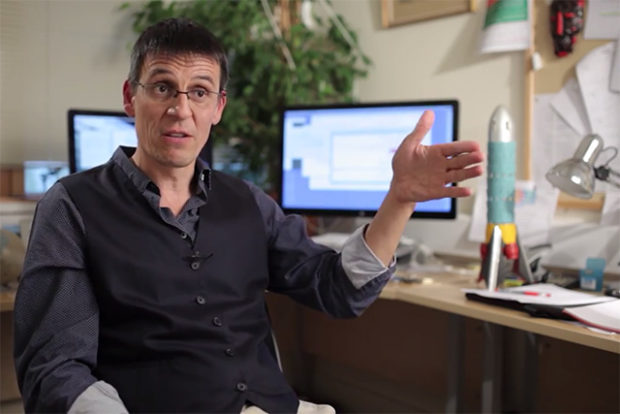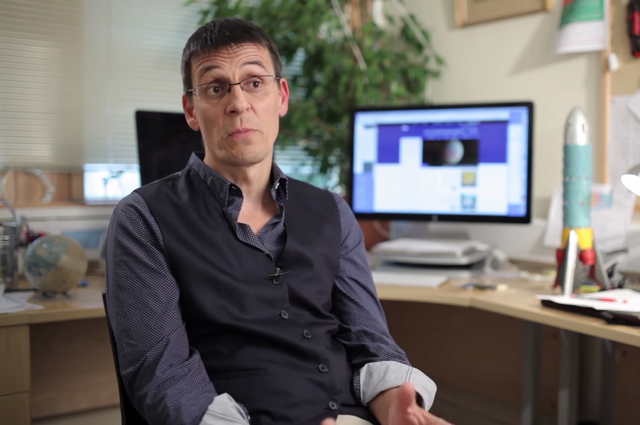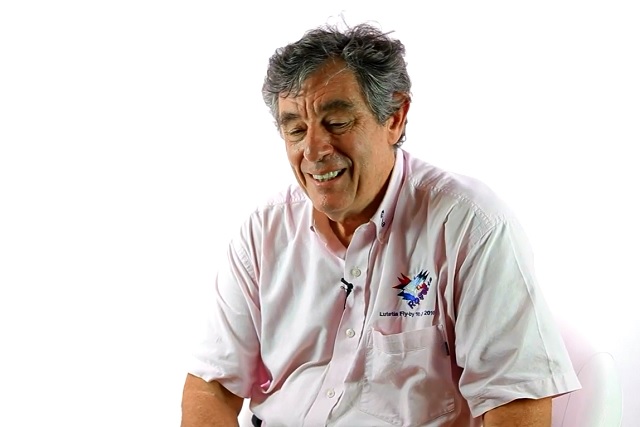Life on Exoplanets
Astrophysicist Didier Queloz on whether we can find life on Mars, Proxima Centauri, and the importance of oxygen
videos | October 17, 2017
The video is a part of the project British Scientists produced in collaboration between Serious Science and the British Council.
We’re looking for exoplanets to understand the solar system, but what we have in mind really here is understanding life. Life on Earth is quite an amazing feature. We have no evidence of life on the other planets in the solar system. Maybe this will change, maybe we’ll find something on Mars, who knows, or on Enceladus and Titan. It will be interesting. But still we will never be sure that if we find life on other planets of the solar system, it is be the same life that we have on Earth and that just moved around, because there are a lot of meteoritic impacts: we received from Mars and the Earth is sending stuff to Mars, it is changing, it is moving a bit in the solar system. So, the question really is: how come you start life on Earth and what do you really need to do for that?
There are some evidences that life was pretty early on, as soon as the Earth is formed, about one billion years after the formation. There is some evidence that there may be life already. It’s an amazing number, because right now we are about 4.6 billion years old. That’s the age of the Sun and that’s the age of the Earth. Life was there for a long time in the solar system and on Earth. The question is: what about other planets? I think, this is one of the most key questions that is behind this whole search for exoplanets. It’s not only about the diversity of the planets, it is not only about the formation of the planets, it’s about finding life, finding life in other systems. Is life a universal process? Is it built the same way?
We have 20 aminoacids building life on Earth, but there are zillions of aminoacids. Why these ones? Are these the ones we need to build life? Do we now have some kind of similar structure to the DNA as well? Is it so unlikely that you start life not in terms of having life early on on Earth, but all the context: what do you need, what are the ingredients, what is the chemistry? Do you need water? I guess so. Do you need nice temperature? I guess so. But is not enough. Do you need a moon? Is the moon an important factor? Do you need Jupiter? Jupiter is a shield for us, it attracts a lot of meteoritic impact and prevents a lot of materials from falling on Earth. There is even a strong theory that seems to suggest that the solar system has had a dramatic event early on, about one million years after the formation, that changed the whole structure of the planets in the solar system and removed a lot of this deadly meteoritic impact that could then kill life afterwards, like it has killed dinosaurs. So, all these are questions that you can start to answer by looking at other planets.

It’s a tremendously difficult question to answer. First, it is because stars are very far, so you cannot just go there. You can barely travel in the solar system and send probes. We do so: we have nice pictures, we even go to Pluto, we even bring fantastic pictures from there, we don’t land but at least we take pictures. This is easy, it’s nothing compared to going to another star. When you need a couple of hours for light to reach the outskirts of the solar system, you need a couple of years to reach nearest stars. The star that is very near to us, Centauri system A and B, and with another star, which is quite famous right now – Proxima, which is the small star. These all belong to a triple system, they all are going around each other. Proxima Сentauri has a planet detected recently. All this is great, fantastic, but it is very far! How could you tell that there is life there? I think, we have some reason to believe that we have at least ways to do that in astronomy.
First, you can study the Earth without being on it. Take any satellite orbiting the Earth – they’re used to predict the weather, they’re used to predict a lot of things like agriculture. By looking you learn a lot, by studying the color in detail. I mean, you can do spectra, you can really try to get a lot of information out of this. So, astronomers will observe atmosphere, they will observe the atmosphere of this planet. This is still tough, but it’s easier than going there. Some of these atmospheres may be a bit easier than others. The Earth’s would be a difficult atmosphere, it has a very small atmosphere (50 kilometers out of 5,000 kilometers, which is the size of the Earth). So, it will be really something difficult to do, but it’s not impossible. It’s certainly more possible to do that than to fly to another planet.
Let’s imagine that we study the atmosphere of an exoplanet. What are we looking for? First, we would look for an atmosphere, because it is understood that to have life you need an atmosphere or at least you would expect life to modify the atmosphere at some point. Life on Earth has completely changed the Earth’s atmosphere. Without life there would not be oxygen. Maybe you can look for something like the oxygen or you can even look for the oxygen. It may tell you that something has happened and has changed the atmosphere of the planet. That’s the kind of idea that astronomy is looking forward to.
We can do more than that, because we cannot only look at a major species, we can look at a bit more rare element. It is the matter of detail: how much detail I get? First, you will look at very easy stuff, and then you will expand and getting better and looking for more details. And then you can play an interesting game. We can go to talk to people doing chemistry on Earth and ask them: “Could you try to reproduce an atmosphere in your lab? Could you try to reproduce life in your lab?” It seems a bit of a silly question these days, but it is not completely impossible that people in labs will start by playing with molecules to try one day to reproduce life. They can just change a bit the composition trying to tell me: “Okay, well, if I have that kind of life, this is what I would expect”. And then by observing and comparing you may slowly get into a perception that you will get something out of life. It will never be a sharp-cut questions like “oh, it’s obvious”. They will be like “okay, there is enough evidence base, there is maybe sixty percent chance”. Then after some time you will be more confident, because you will have more detail and you will build up a better knowledge, and you will know “okay, now I know better than I believed, there is more chance”. This is the kind of process that we hope to go.
It’s a tremendous process and it is difficult, and it requires a couple of elements. First, we need a planet. We need a good planet. We need a planet that we think may have life. So, what is this planet? Well, we think that this planet is not too big (otherwise it cannot have life), because if you get hydrogen, full of gas, you cannot stay there, you need to be able to sit on it. We believe we need water. We believe we should look for a rocky planet with water. You can have a lot of water or a little bit of water, but you need to have both there.
Then you need the planet to be located at the right distance to the stars. There has been quite a lot of modeling they’re trying to define what is the right distance. Let’s imagine that we are on Earth, and we change the orbit of the Earth – we go a little bit closer, next to Venus. What will happen? You will increase the temperature on Earth. There is a point when you increase so much, then you will build up too much gas and you will build up a greenhouse effect. It’s a global warming, extreme global warming. Then you will practically burn everything and end up like Venus. So, you are too close.
If you move away, it will still be nice for some time, but then it would become so cold on Earth. Slowly everything will freeze, and Earth will not have any more oceans, they will be completely frozen. We think that without liquid water it would make life difficult. So, there is a range, which turns out to be between Venus and Mars, for the star like the Sun.There are different kinds of stars. Some of these stars are much smaller. When a star is smaller, the temperature of the star is way cooler. So, the Sun is about 5,700 degrees on the surface. If you take smaller stars, they are called M-stars, you get down to 4,000 – 3,000, even 2,500 (that’s the coolest star you can get). So, these stars are much cooler, so you can get much closer. Practically, if you want to be at the right location with these stars, you have to be much closer. And that’s an interesting part of it, because you don’t need to be orbiting with a one year period – you can be orbiting with 5-10 days, maybe 20 days around it. That’s exactly what is happening for this planet detected on Proxima Centauri – 11 days. The star is very small.
It turns out and if you do the mathematics you realize that the temperature is just fine. This concept is called “habitable zone”. For each of the stars you can define where the right place would be, and then you can optimize the search. We can try to figure out, Okay, if I find a planet like the Earth close to the star and if the star is small, I should look for life. It’s a good place. I can also look for a planet further out, if the star is brighter.
So, there is a full range of different kind of stars, different kind of planet. Keeping the fact that it has to be rocky, and this is something you can get from the size. We understand that the planet smaller (1.3 times the size of the Earth) should be okay. A planet of about 3-4 times the mass of the Earth – is okay. Down to Mars is okay. If you are too small, then you cannot keep the atmosphere, because there’s not enough gravity. So, there is a good range between half of the Earth and 2-3 times of the Earth, will be good mass. And there is a distance that depends on the star.
We are now finding this target. This is today, this is going on. We are detecting by now these planets. And tomorrow we will observe the atmosphere and we may get first hints, something is going on. In 20 years, 50 years there will be a complete new paradigm, because people will have evidence of atmosphere on some of these planets. And for the first time they will be able to tell how likely you may have life or not. That is amazing, because in just 20 years we have made so much progress. We’ve moved from an idea “well, there may be live elsewhere” to being able to tell that this planet on that star may have life.






























